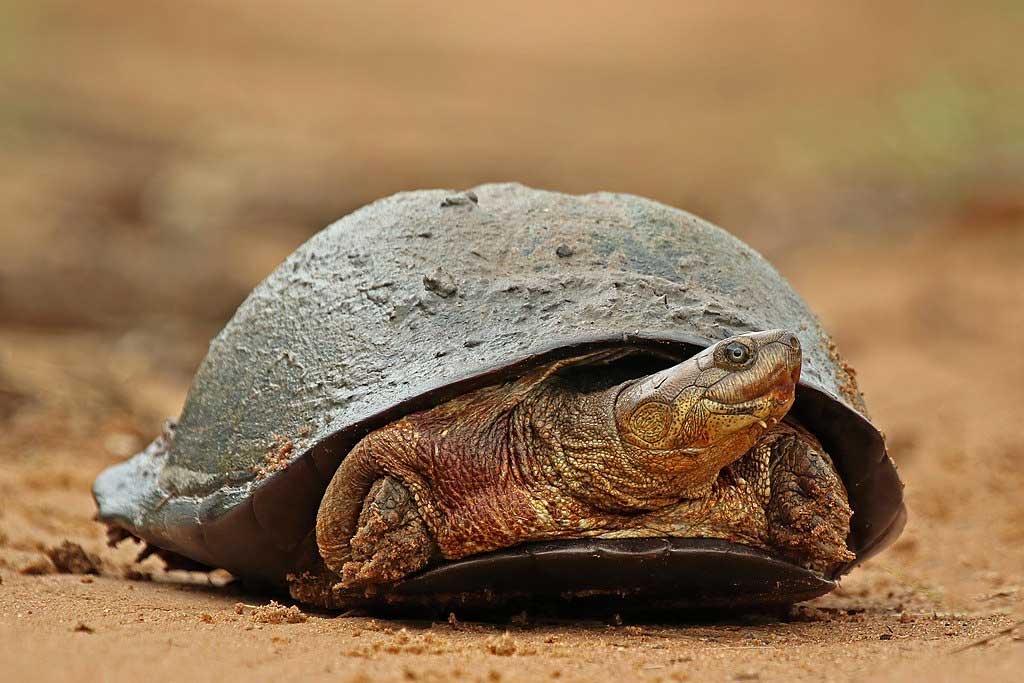
Content |
|---|
Origin / Distribution
Since 2014 ten species have been distinguished. It also, there are two others that have not yet been fully classified:
Other subspecies:
Pelomedusa barbata, Pelomedusa gehalfie, Pelomedusa kobe, Pelomedusa neumanni, Pelomedusa olivacea, Pelomedusa schweinfurthi, Pelomedusa somailca, Pelomedusa variabilis.
The African helmeted turtle, whose scientific name is Pelomedusa subrufa, lives in southern and eastern Africa and in the southwestern Arabian Peninsula. The distribution area extends from Senegal in the west to Madagascar in the east and to South Africa.. So far, it was assumed that it was a single species that inhabited this wide area. But, There are many species, some of which have very small home ranges.
Characteristics / Appearance
The African helmeted turtle has a very round and flat shell. It is dark brown to olive green in color.. The plastron is usually black, but may also have a yellow/horned coloration.
The skin is dark in color on top. Like this, the upper part of the tail is black and the extremities dark gray. The underside of the head is light gray, almost white. The African helmeted turtle he has a round head, short snout and round eyes. they also smile. Sex is recognized by the tail. The tail of the males is longer and thicker than that of the females..
They are called neck spinners. (Pleurodia) and, Therefore, they cannot fit their heads vertically into the S-shaped shell. On the other hand, they put it on its side, horizontal s-shaped, against the body.
Size: The Pelomedusa reach a length of 14 to 30 cm and weighing up to more than 2 kg, depending on the species. The males grow a little more. The Pelemedusa subrufa it is the smallest species, Medusa galeata the largest.
Life expectancy: 30-50 years
Habitat
Preferred habitat is swamps and still waters. It also sometimes temporarily inhabits existing waters and travels considerable distances to reach new habitats.. If accessible waters dry up, is buried until 5 cm deep in the mud. Depending on the exact area of origin, temperatures can vary greatly between day and night.
Behavior
The African helmeted turtle it is a relatively peaceful turtle and predominantly crepuscular or nocturnal. They spend a lot of time on the bottom and also like to burrow in the sand.. In the African winter months, they maintain a dry dormancy and bury themselves in the mud to do so. Dry torpor is followed by the rainy season, during which animals become extremely active.
Threats to the species
No conservation status. But, Saudi Arabia is currently working on conservation measures for the various species that are not as widespread. Until very recently, one of the species was assumed to be distributed throughout Africa. But, there are several and one species is already in serious danger of extinction.
The "African helmeted turtle" in captivity

Aquaterrarium
The African helmeted turtle needs a large aquaterrarium (minimum requirement 5×2.5 (LxA) of carapace length, that is to say, 130-150 cm length depending on the species). The water level should be 30-40 cm.. It also, They need a large land area that accounts for approximately 1/3 of the total area. This should be filled especially with moist sand or substrate, for the ones pelomedus can dig during dry break. For dry idle, the water level must drop constantly to simulate the desiccation of the natural habitat. The dry break is followed by the rainy season, during which the water level must be replenished.
Egg laying place: When you have females, an egg-laying place is always necessary. However, these turtles must have a sand pit large enough to rest dry.
Lighting and temperature
They should not miss the sources of ultraviolet light and heat. To the African helmeted turtle likes to sunbathe on land and also needs high temperatures. The water must also be heated (to. 22-30°), as our ambient temperatures are well below African conditions. Heaters that are attached directly to the tank are not recommended, since glass bodies don't necessarily support turtles. A heater built into the filter is more suitable. This heater must work with a timer to guarantee night emission. Spot heaters prevent animals from getting cold when they get out of the hot water. If the temperature of the air is lower than that of the water, pneumonia can occur. Fluorescent tubes provide enough light in the tank. In any case, need a big filter. In the case of aquatic turtles, it is said to always use a filter that can handle one and a half times the actual amount of water, since turtles pollute the water more than fish.
Diet
Turtles Pelomedus have a predominantly carnivorous diet. The right food is earthworms, the snails, mussels and fish. A cuttlefish bone should be available. In the wild it also feeds on frogs and carrion.. It has also been observed that pelomedus they snatch and drown the birds that bathe. Plant food includes aquatic plants, estate, flowers and fruits. But, they also eat them only in the water.
Buy one "African helmeted turtle"
most of the turtles Pelomedusa found in the animal trade in Europe are called “subrufa” in the shops.
The price for the offspring of the "African helmeted turtle" at the exotic animal market, ranges between 25 – 40 EUR.
Videos "African helmeted turtle"
|
|
|
|---|
Alternative names:
1. African helmeted turtle, Marsh terrapin, Crocodile turtle, African side-necked turtle (English).
2. Tortue à cou caché d'Afrique, Péloméduse rousse, Péloméduse roussâtre (French).
3. Starrbrust-Pelomedusen (German).
4. Tartaruga-de-capacete-africano, Tartaruga de pântano, Tartaruga de crocodilo, Tartaruga-de-pescoço-africano (Portuguese).
5. "Tortuga de escudo africana", Tortuga de casco (español).
